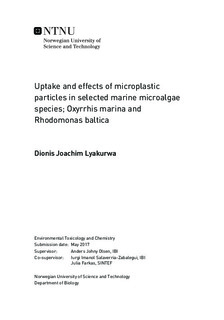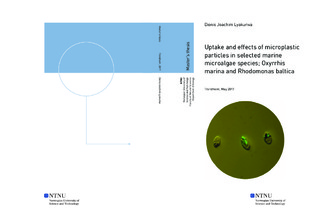| dc.description.abstract | It is estimated that large numbers of microplastics are present in the marine environment and their concentrations are expected to rise in a foreseeable future. Interactions, uptake, and excretion rates as well as effects of microplastics on biota remain largely unknown. Here we used two algae species to investigate 1) the uptake of 10 µm virgin polystyrene (PS) microbeads and 1-5 µm green fluorescent (GF) microbeads in the dinoflagellate Oxyrrhis marina Dujardin (12-30 µm); and 2) interactions and effects of 10 µm virgin polystyrene (PS) microbeads in the cryptophyte Rhodomonas baltica Karsten (5-10 µm). O. marina (fed R. baltica 1:6 ratio of cell number) were exposed to 75 or 7500 microbeads/mL of GF (1-5 µm) or PS (10 µm) particles under continuous mixing for 60 min. Measurements of particle concentrations, volumes and size distributions were done at 0, 10, 25, 40 and 60 min using a coulter counter. R. baltica (2000 cells/mL) were exposed to 75, 750 and 7500 PS particles/mL and cultured in 40 mL vials on a plankton wheel at 24°C for 264 h. Particle concentrations, chlorophyll content, and pH were measured at 24 h intervals until the algae density levelled off at the maximum carrying capacity of the system. At the end of the experiment, samples of the microalgae-microplastics mix were examined visually using light/fluorescence microscopy to confirm ingestion of microbeads by O. marina or interactions of R. baltica with PS microbeads. Our results showed that O. marina ingests both PS and GF microbeads at the expense of microalgae uptake (R. baltica), and, at high PS concentration, serious adverse effects on O. marina were observed characterized by food replacement and loss of motility. Possibly O. marina preferred PS, due to particle size and/or polymer type. A non-monotonic dose-response relationship was observed between PS microsphere concentration and R. baltica production rate, which strongly correlated with pH in the exposure media as well as fluorescence and hence chlorophyll production. Shading and biofouling are possible mechanisms of action of microplastics impacts on autotrophic microalgae such as R. baltica. | |

